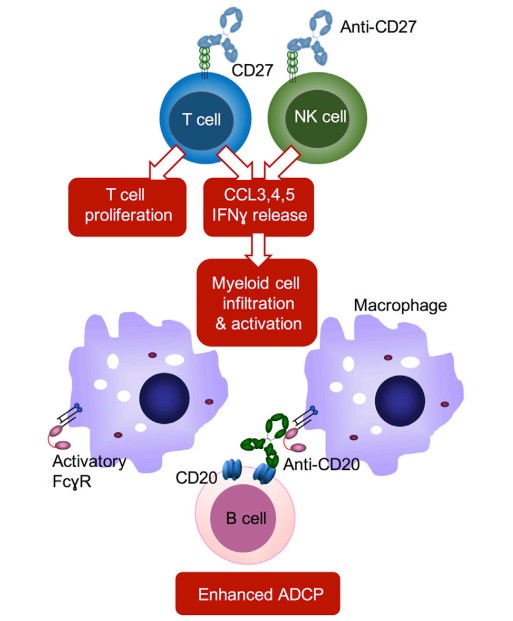Hi-Affi™ hPD-L1/hCD27 Dual Humanized Mouse Model
Preclinical studies demonstrated that the anti-CD27 agonist antibody could promote the anti-tumor immunity through multiple immune cells and chemokines. Considering the limitations of single-drug therapy, combining the anti-CD27 agonistic antibody with other immune checkpoint inhibitors, such as the anti-PD-L1 antibody could be a potential cancer treatment. Creative Biolabs has successfully established an optimized Hi-Affi™ “humanized” animal platform to offer specialty manipulated hPD-L1/hCD27 dual humanized mice for our clients all over the world.
hPD-L1/hCD27 Molecule
Human programmed cell death-ligand 1 (hPD-L1) is widely expressed in activated T cells, B cells, and macrophages. The negative regulation of immune responses is achieved by hPD-L1 interacting with its receptor human programmed cell death protein 1 (hPD-1). hPD-L1 binds to the receptor hPD-1 on T cells, which inhibits the activation of T cells and causes apoptosis of T cells. In various human tumor tissues, hPD-L1 protein expression can be detected.
Human CD27 (hCD27) is a member of the tumor necrosis factor receptor superfamily (TNFRSF). The hCD27 gene is located in the short arm of the chromosome 12 region 1 band (12p11). hCD27 molecule is a dimer structure and belongs to type I transmembrane glycoprotein. hCD27 resides in CD4+ and CD8+ T cells. During the activation of T cells, hCD27 expression increases transiently, but when T cells undergo several rounds of differentiation, the expression of hCD27 is down-regulated. Through the activation of antigen receptors, hCD27 is also expressed in B cells, and it is a typical sign of memory B cells. Besides, hCD27 is expressed in natural killer cells (NKs).
hPD-L1/hCD27 Signal Pathway
After the hPD-1/hPD-L1 pathway is activated, it suppresses the immune system in cancer. Additionally, hPD-L1 can bind to CD80, competitively inhibiting the T cell activation pathway that CD80 binds to ligands, which is another mechanism for hPD-L1 to inhibit T cell activity.
hCD27 and its ligand hCD70, by linking the TRAF family members (TRAF2 and TRAF5), induce NF-κB and c-Jun-N terminal kinase signaling pathways. Ligation of hCD27 and hCD70 could promote T cell proliferation and corresponding cytokines secretion. When hCD27 on B cells is activated, it can promote the differentiation of B cells into plasma cells, thereby stimulating the production of immunoglobulins. The activation of hCD27 can fully induce the proliferation of NKs and the production of IFN-γ, thereby increasing the cytotoxicity of NKs. Consistently, a recent study reported that anti-CD27 agonist antibody has the ability to: 1. increase the number of CD8+ T cells; 2. enhance the secretion of IFN-γ and chemokines of CD8+ T cells and NKs; 3. increase the infiltration of macrophages in the tumor microenvironment; 4. augment the antibody-dependent cellular phagocytosis.
 Fig.1 Anti-tumor immunity enhanced by CD27 agonists. (Turaj, 2017)1, 2
Fig.1 Anti-tumor immunity enhanced by CD27 agonists. (Turaj, 2017)1, 2
Development of hPD-L1/hCD27 Dual Humanized Mice
The anti-hPD-L1 antibody has been evidenced by the ability to relieve the suppression of the T cells. And anti-hCD27 agonist antibody could activate the anti-tumor immunity via stimulating the function of T cells, NKs, and macrophages. These findings provide a therapeutic potential of combining the anti-hPD-L1 antibody and anti-hCD27 agonist antibody for cancer treatment. Creative Biolabs provides multiple types of Hi-Affi™ “humanized” animal models, including the hPD-L1/hCD27 dual humanized mice. We have assisted our global clients in their study projects using our humanized mice. With many years of CRO services, we have accumulated much experience in preclinical novel drug development. If you have any questions about your research, please let us know. Our scientists will provide you with solutions to any of your problems to advance your study project.
Creative Biolabs also offers other various Humanized Mouse Models you may be interested in:
References
- Turaj, A. H.; et al. Antibody tumor targeting is enhanced by CD27 agonists through myeloid recruitment. Cancer Cell. 2017, 32(6): 777-791.
- under Open Access license CC BY 4.0, without modification.
For Research Use Only.
